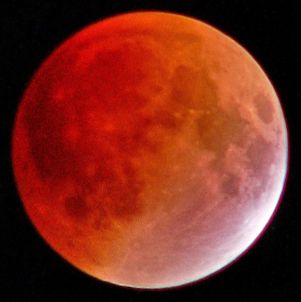Tritos series
The tritos series repeats 31 days short of 11 years at alternating nodes. Sequential events have incremental Saros cycle indices.
This series produces 20 total eclipses between April 24, 1967 and August 11, 2185, only being partial on November 19, 2021.
Saros series
Lunar saros series 128, repeating every 18 years and 11 days, has a total of 71 lunar eclipse events including 57 umbral eclipses (42 partial lunar eclipses and 15 total lunar eclipses). Solar Saros 135 interleaves with this lunar saros with an event occurring every 9 years 5 days alternating between each saros series.
| Greatest | First |
|---|

The greatest eclipse of the series occurred on 1953 Jul 26, lasting 108 minutes. [3] | Penumbral | Partial | Total | Central |
|---|
| 1304 Jun 18 | 1430 Sep 2 | 1845 May 21 | 1899 Jun 23 |
| Last |
|---|
| Central | Total | Partial | Penumbral |
|---|
| 2007 Aug 28 | 2097 May 21 | 2440 May 17 | 2566 Aug 2 |
Lunar Saros 128 contains 15 total lunar eclipses between 1845 and 2097 (in years 1845, 1863, 1881, 1899, 1917, 1935, 1953, 1971, 1989, 2007, 2025, 2043, 2061, 2079 and 2097). Solar Saros 135 interleaves with this lunar saros with an event occurring every 9 years 5 days alternating between each saros series.
Half-Saros cycle
A lunar eclipse will be preceded and followed by solar eclipses by 9 years and 5.5 days (a half saros). [4] This lunar eclipse is related to two annular solar eclipses of Solar Saros 135.

A total lunar eclipse occurred on 28 August 2007, lasting just over 90 minutes. The Moon entered the Earth's penumbra at 7:53:40 UTC. The first partial phase began in earnest at 8:51:16 UTC when the Moon entered the Earth's umbra. It exited the penumbra at 13:20:57 UTC.

A total lunar eclipse took place at 0308 UT (GMT) on Thursday, August 17, 1989, the second of two total lunar eclipses in 1989.

A total lunar eclipse will take place on July 7, 2047. It will last 1 hour 40 minutes and 49 seconds and will plunge the full Moon into deep darkness, as it passes right through the centre of the Earth's umbral shadow. While the visual effect of a total eclipse is variable, the Moon may be stained a deep orange or red colour at maximum eclipse. This will be a great spectacle for everyone who sees it. The partial eclipse will last for 3 hours and 39 minutes in total.
A total lunar eclipse took place on Friday, August 6, 1971, the second of two total lunar eclipses in 1971. A dramatic total eclipse lasting 1 hour, 39 minutes and 24.8 seconds plunged the full Moon into deep darkness, as it passed right through the centre of the Earth's umbral shadow. While the visual effect of a total eclipse is variable, the Moon may have been stained a deep orange or red colour at maximum eclipse. This was a great spectacle for everyone who saw it. The partial eclipse lasted for 3 hours, 35 minutes and 31.9 seconds in total. Occurring only 2.2 days before perigee, the Moon's apparent diameter was 3.6% larger than average and the moon passed through the center of the Earth's shadow.

A total lunar eclipse will take place on 7-8 September 2025. The Moon will barely miss the center of the Earth's shadow. It will be the second of two total lunar eclipses. Occurring roughly 3 days before perigee, the Moon will appear larger than usual.

A total lunar eclipse took place on Sunday, July 26, 1953.

A penumbral lunar eclipse will take place on June 15, 2049.

A total lunar eclipse will take place on January 1, 2048. It will be the first recorded lunar eclipse to be visible on New Year's Day for nearly all of Earth's timezones. The next such eclipse will occur in 2094.

A partial lunar eclipse will take place on January 22, 2046.

A penumbral lunar eclipse will take place on March 3, 2045.

A total lunar eclipse will take place on March 13, 2044.

A total lunar eclipse will take place on March 25, 2043.

A partial lunar eclipse will take place on July 18, 2046.

A partial lunar eclipse will take place on June 26, 2048. The Moon will be strikingly shadowed in this deep partial eclipse lasting 2 hours and 39 minutes, with 63.88% of the Moon in darkness at maximum.

A total lunar eclipse will take place on January 12, 2047.

A penumbral lunar eclipse will take place on May 17, 2049.

A total lunar eclipse will take place on April 26, 2051.

A total lunar eclipse will take place on October 30, 2050.

Saros cycle series 128 for lunar eclipses occurs at the moon's ascending node, repeating every 18 years 11 and 1/3 days. It contains 71 events. Solar saros 135 interleaves with this lunar saros with an event occurring every 9 years 5 days alternating between each saros series.

A total lunar eclipse took place on Tuesday, July 16, 1935. It was a central eclipse, passing through the darkest part of the shadow.
This page is based on this
Wikipedia article Text is available under the
CC BY-SA 4.0 license; additional terms may apply.
Images, videos and audio are available under their respective licenses.

































































































